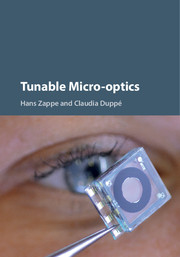Book contents
- Frontmatter
- Dedication
- Contents
- List of contributors
- List of acronyms
- Part I Introduction
- Part II Devices and materials
- 3 Soft-Matter Micro-optics
- 4 Tunable Reflective Optics
- 5 Tunable Liquid Lenses
- 6 Optofluidic Micro-shutters and Micro-irises
- 7 Solid Body Elastomeric Lenses
- 8 Spatially Tunable Polarization Devices
- 9 Aluminum Nitride and Diamond Membranes for Tunable Micro-optics
- 10 Piezoelectrically Actuated Tunable Microlenses
- Part III Systems and Applications
- Index
- References
7 - Solid Body Elastomeric Lenses
from Part II - Devices and materials
Published online by Cambridge University Press: 05 December 2015
- Frontmatter
- Dedication
- Contents
- List of contributors
- List of acronyms
- Part I Introduction
- Part II Devices and materials
- 3 Soft-Matter Micro-optics
- 4 Tunable Reflective Optics
- 5 Tunable Liquid Lenses
- 6 Optofluidic Micro-shutters and Micro-irises
- 7 Solid Body Elastomeric Lenses
- 8 Spatially Tunable Polarization Devices
- 9 Aluminum Nitride and Diamond Membranes for Tunable Micro-optics
- 10 Piezoelectrically Actuated Tunable Microlenses
- Part III Systems and Applications
- Index
- References
Summary
Introduction
Lenses with tunable optical properties have been subject of extensive research. Lens elements able to change their focal length dynamically, that is, without complex mechanics to move the lens elements along the optical axis, will further facilitate the miniaturization of optical systems while maintaining their flexibility. Downscaling of optical systems will not only make consumer products smaller and more versatile, but one day, they might provide high-quality images in endoscopic surgery and thus support medical diagnostics.
This chapter considers current research on tunable elastomeric lenses – lenses that consist entirely of elastic, transparent silicone and whose optical properties may be tuned via application of strain. Our research is motivated by the versatility of implementation and the high optical quality elastomeric lenses can achieve when compared with other tunable lens approaches.We will show that we are able to fabricate any desired lens shape, including lens stacks and lenses corrected for aberrations, which consist of elastic material. We discuss several actuation principles, and we show that asymmetric wavefront aberrations, for example astigmatism, are directly addressable by asymmetric deformation of the lens.
Elastomeric lenses have numerous advantages over other tunable lens approaches, an overview of which is given in Chapter 1. Since the lenses are fabricated by molding from optical surfaces, the quality is high and the lens can take any desired shape, including spherical or optimized aspherical shapes (Liebetraut et al. 2012). An additional advantage is that the lenses could be mass produced. Due to their completely elastic nature, elastomeric lenses are shock resistant and have good long-time stability. The employed material shows only linear elastic behavior, such that the focal length tuning is linear as well (Liebetraut et al. 2011). Miniaturized actuation of elastomeric lenses remains challenging but we have shown that we can directly influence wavefront errors such as astigmatism by applying asymmetric strain (Liebetraut et al. 2013a, Schuhladen et al. 2013). Even though the focal tuning efficiency of about 10% of its original focal length is somewhat limited, this range is sufficient to refocus while additional refractive power is provided by another element.
Concept
Tunability is one of the most remarkable features of the human eye: an elastic lens, shown in Figure 7.1a, dynamically changes its focal length. Thus the lens images objects at variable distances sharply on to the retina.
- Type
- Chapter
- Information
- Tunable Micro-optics , pp. 176 - 196Publisher: Cambridge University PressPrint publication year: 2015
References
- 1
- Cited by

